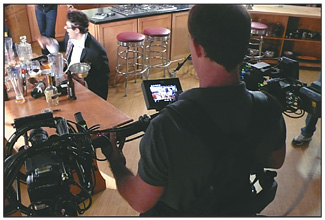OLED Interest Slow, But Growing
LOS ANGELES
Ever since the demise of the CRT, the broadcast industry has been looking for the next best display technology for critical video monitors. The deep blacks offered by plasma screens seemed appealing for a while, but recently many control rooms and edit bays have opted for the greater power efficiency, lower cost and lighter weight of LCD displays such as Sony’s BVM-L231 Critical Evaluation Monitor.
LESS POWER

But recently there has been growing interest in a new technology called OLED (Organic Light Emitting Diode) because, among other benefits, OLED screens do not require a backlight and can therefore function with considerably less power requirements than LCD’s. In addition, since a self light-emitting OLED display is comprised of just an emissive layer, a conductive layer, a substrate, and anode and cathode terminals, an OLED screen can be paper thin and very lightweight. Intriguingly, because OLED is based on the principle of electroluminescence, its polymer dye layers can even be printed onto glass or a flexible plastic foil.
Interest in active matrix OLED (AMOLED) displays in consumer devices such as cell phones and portable media players has been growing, surpassing the limited deliveries of passive OLED (POLED) screens. But the future for OLED in general is predicted to be robust. In their “Quarterly OLED Shipment and Forecast Report” released in April, DisplaySearch, a market research firm reporting on display-related industries, forecast the total OLED display market will grow from $0.6 billion in 2008 to $5.5 billion by 2015, representing a compound annual growth rate of 37 percent.
Several consumer TV manufacturers including LG Electronics and Samsung have demonstrated prototype OLED home displays, but in December 2007, Sony launched the world’s first commercially available OLED TV, the 11-inch XEL-1, incorporating Sony’s proprietary “Organic Panel.” Sony has announced a more than $242 million investment to accelerate the production of “large size, high image quality OLED panels.”
Last April, Marshall Electronics introduced its V-OL761-HAD 7.6-inch OLED portable field/camera-top production monitor housed in a rugged lightweight case. Since then, the company has decided to withhold the V-OL761-HAD while they gauge the broadcast and film industry’s reaction to OLED technology.
MULTIPLE ANGLES
Interest in OLED display technology for the professional market, however has been slow due to the size limitations of available panels, (generally limited to less than 7.6 inches), but is growing. Tamuz presented its Black Hawk OCM 107W professional video OLED monitor at the 2009 NAB Show featuring a high resolution 7.6-inch AMOLED HD-native screen with a brightness level of 250 nit (candela per square meter) and a contrast ratio of 100,000:1, and it has already started shipping.
Ramon Engle, owner of Suspended Vision and a Steadicam and MK-V AR body mounted camera stabilization rig operator in New York, was the first to use the Tamuz Black Hawk OCM 107W when shooting “Good Eats” with Alton Brown for the Food Network.
“The image quality in full sunlight of the Black Hawk OCM 107W is great even when compared to a 1,000 nit LCD screen,” Engle said. “But the greatest advantage of this OLED monitor is the ability to view its display at very off axis angles. Even looking almost directly parallel to the screen, I can still see an image.”

Ramon Engle was the first to use the Tamuz Black Hawk OCM 107W when shooting “Good Eats” with Alton Brown for the Food Network. As a camera operator whose monitor is permanently mounted 3 feet from his head, the high resolution of the Black Hawk OCM 107W, is invaluable either when shooting outside in daylight or indoors at night. “I can’t just jam my eye into a viewfinder,” Engle said, “so it is very important to get all the detail I can muster out of the screen since I am in very awkward positions most of the time. And the color rendering and extreme contrast of the Tamuz Black Hawk OCM 107W video monitor is very valuable in the field.”
Thore Sievers, head of manufacturing at Tamuz, is convinced OLED will become mainstream for video monitors in the not distant future. “Their lower power consumption saves money, and the contrast ratio, viewing angle and black levels of OLED are too good to be ignored,” Sievers said. “In my personal opinion, They may replace LCD and plasma completely.”
One reason is the incredible contrast ratio available from OLED. “We will see contrast ratios of more than 250,000:1 in the near future,” Sievers said.
In June, Won Kim, vice president of OLED sales and marketing for LG Electronics, announced a 15-inch OLED TV with a 1,000,000:1 contrast ratio, 1366x768 resolution and a 30,000-hour shelf life that will begin shipping by the end of this year in Korea, with domestic sales to follow.
Improvements in OLED technology will empower its acceptance in the professional video monitor market, according to Ken Werner, a senior analyst at Insight Media and principal of Nutmeg Consultants.
“The panel Sony built into its first home OLED display, the 11-inch XEL-1, used technology that was not yet ready which made it very expensive and did not give the set a long enough lifetime,” he said. “But with the significant investments some major players are making in OLED technology, the advantages of its lower power consumption, increased color gamut and amazing contrast ratio may enable it to become a competitor to professional LCD displays once larger glass substrates become more widely available. I do believe we’ll see professional OLED video monitors of moderate or larger size in reasonable volume, but it will probably be 2012 or later before they hit the market.”
The professional video industry's #1 source for news, trends and product and tech information. Sign up below.
